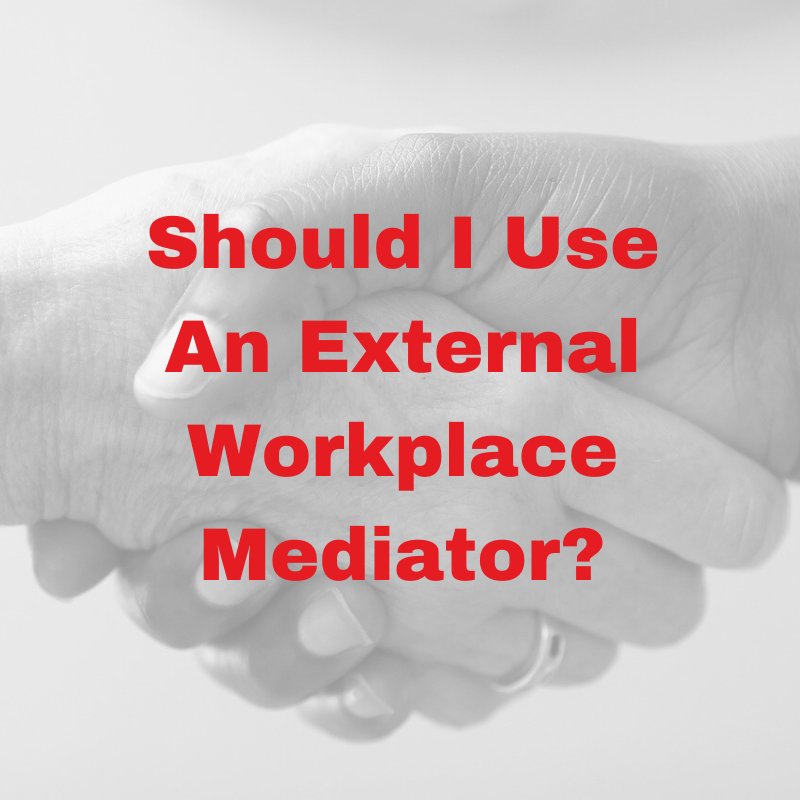
If you have a dispute between a number of your team you might be considering whether you should use an external workplace mediator to settle it.
Mediation is a great way to bring harmony back to a workplace if your staff or managers have a disagreement. You might bring in a workplace mediator if:
- Your employees cannot settle a disagreement themselves.
- It is affecting the productivity or culture of the workplace.
- The issue does not require a disciplinary or grievance procedure.
On these occasions, mediation can work wonders by helping both parties reach mutual understanding and acceptance.
Can you mediate a workplace disagreement yourself or should you use an external workplace mediator?

Do You Have To Use A Professional Workplace Mediator?
You don’t have to use a professional workplace mediator. You can carry out the mediation yourself or have a colleague do it.
However, mediation is a skill in which a professional workplace mediator is trained and experienced.
We have been to workplaces where well-meaning managers have had a go a mediating a disagreement and it has actually made things worse.
Your staff may not want to share their personal thoughts and feelings with another work colleague. If their level of trust is already compromised, an employee may be reluctant to ‘share’.
Talking to a professional person who is not known to anyone within the company and has no potential conflict of interest means employees with issues are more likely to engage and talk.
This greatly increased the chances of mediation having a positive outcome.
What Does A Trained Mediator Do?
For mediation in the workplace to be effective, both parties should be willing to try it and open to a positive outcome.
Mediation must be voluntary, so you cannot force your employees to engage with a workplace mediator.
A trained external workplace mediator will usually follow a five-step process:

1) Introduction and Assessment
The first step is introductions. Here at Metis HR, we do this through an initial phonecall. We introduce ourselves, talk to each party and get the basic outline of the dispute.
At this stage, our skilled mediator starts to establish trust and boundaries with both parties in a friendly way, highlighting our neutrality.
We also use this time to put both parties at ease and check that they really do wish to participate in the process.
The process and time frame will also be explained so everyone involved feels fully briefed.
2) Opening Statements
This is the opportunity for each of the disputing parties to state what they feel the problem is. The mediator will stress to both parties to not react to each others statements, but to be respectful and just listen.
They will take it in turns to explain their grievances and be heard.
It is the role of the mediator to ensure this does not lead to arguments or insults. This is done with both parties face to face. It is an important step in the process and is usually the first time they have heard each other’s perspective.
This is a simple outline of the situation. It allows the workplace mediator to get a general overview of the problem.
3) Details And Understanding
Next, the workplace mediator will spend time with each party, separately to get the full picture of the dispute.
They will hear facts, opinions, and hearsay and will use this to piece together a complete side of the story.
Often this time helps the mediator build rapport and trust with the individuals.
This is where using an external mediator can really pay dividends, as their neutrality is generally more accepted and they can skilfully extract the root causes of the problem.
The workplace mediator will start to understand what areas of the problem are solvable and by what methods or agreements.
4) Negotiation
Once the workplace mediator has collated as much information as they feel they can, they can begin to negotiate a resolution between the parties.
This can sometimes be expedited by holding this part of the session with the parties kept separate in the beginning. Eventually the mediator will ask if the two parties wish to come together to draw up an agreement. Only when both parties agree will they be brought back together.
This part will often require compromise from both parties, but a skilled mediator will understand how much each person is willing to compromise.
5) Resolution
When a successful resolution has been found that both parties are happy with, the mediation process comes to a close.
Both parties are asked to commit to upholding the resolution, usually by drawing up a mutual agreement and signing it.
Should I Outsource To A Workplace Mediator?
Outsourcing to a skilled workplace mediator can be a big benefit if you are seeking to resolve a workplace dispute between two colleagues or groups of colleagues.
The process above requires fantastic interpersonal skills, total neutrality, and the ability to gently negotiate.

When a skilled mediator helps people reach a resolution, it can save you time and money. It can also help you retain your best staff and avoid a disciplinary or grievance.
Outsourcing this function means you can access the skills and experiences of a trained professional and know that there is an outcome to be found, they will find it.
How Do I Start Workplace Mediation?
The first step in starting workplace mediation is to find a mediator that you can trust and like.
Our workplace mediator, Alison Penney has a qualification in workplace mediation from Globis Mediation and 10 years of experience as a qualified Master Practitioner in Neuro Linguistic Programming. This puts her in the perfect position to effectively mediate in many scenarios.
If you would like to speak to Alison about starting workplace mediation in your workplace, or even if it is the right approach to solving workplace disagreements, just get in touch.
You can call us on 01706 565 332 or email info@metishr.co.uk. We will be happy to talk you through the process and our experience.

